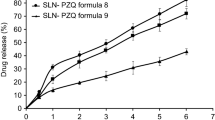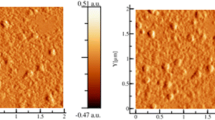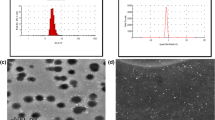Abstract
The goal of the present work consisted of the formulation development and evaluation of quinapyramine sulphate (QS)-loaded long-acting oil-based nanosuspension for improved antitrypanosomal effect. QS was transformed into a hydrophobic ionic complex using anionic sodium cholate (Na.C). The complex was characterized by FTIR, DSC, and XRD. Oil-based nanosuspension was prepared by dispersing the QS-Na.C complex in thixotropically thickened olive oil. The nanoformulation was found to be cytocompatible (82.5 ± 5.87% cell viability at the minimum effective concentration [MEC]) in THP-1 cell lines and selectively trypanotoxic (p < 0.0001). The pharmacokinetic studies of QS-Na.C complex-loaded oily nanosuspension showed 13.54-fold, 7.09-fold, 1.78-fold, and 17.35-fold increases in t1/2, AUC0-∞, Vz/F, and MRT0-ꝏ, respectively, as compared to free QS. Moreover, a 7.08-fold reduction in plasma clearance was observed after the treatment with the optimized formulation in Wistar rats. Furthermore, treatment with QS-Na.C complex-loaded oily nanosuspension (7.5 mg/kg) in T. evansi-infected mice model showed the absence of parasitaemia for more than 75 days after the treatment during in vivo efficacy studies. The efficacy of the treatment was assessed by observation of blood smear and PCR assay for DNA amplification. To conclude, our findings suggest that the efficient delivery of QS from the developed QS-Na.C complex-loaded oily nanosuspension could be a promising treatment option for veterinary infections against trypanosomiasis.
Graphical Abstract






Similar content being viewed by others
Availability of data and materials
The datasets generated during the study are available from the corresponding authors upon request.
References
Manual MV. Drugs commonly used for trypanosomiasis in domestic animals [Internet]. [cited 2023 Jan 4]. Available from: https://www.msdvetmanual.com/multimedia/table/drugs-commonly-used-for-trypanosomiasis-in-domestic-animals.
Prayag K, Surve DH, Paul AT, Kumar S, Jindal AB. Nanotechnological interventions for treatment of trypanosomiasis in humans and animals. Drug Deliv Transl Res. 2020;10:945–61.
Murray M, Gray AR. The current situation on animal trypanosomiasis in Africa. Prev Vet Med Elsevier. 1984;2:23–30.
Health T center for food security and public H. African animal trypanosomiasis. 2009.
Yashica Pharmaceuticals Pvt. Ltd. Product Information- Quinapyramine Chloride/Sulphate BP [Internet]. [cited 2022 Jul 6]. Available from: https://www.pharmarawmaterials.com/quinapyramine-chloride-sulphate.html.
Vollner H. Determination of the trypanocidal drugs homidium, isometamidium and quinapyramine in bovine serum or plasma using HPLC Isometamidium and Quinapyramine in bovine serum or plasma Vollner. 2018.
Manuja A, Kumar S, Dilbaghi N, Bhanjana G, Chopra M, Kaur H, Kumar R, Manuja B, Singh SYS. Quinapyramine sulfate-loaded sodium alginate nanoparticles show enhanced trypanocidal activity. Nanomedicine. 2014;9:1625–34.
Manuja A, Dilbaghi N, Kaur H, Saini R, Barnela M, Chopra M, Manuja B, Kumar R, Kumar S, Riyesh T, Singh SYS. Nano-structures & nano-objects chitosan quinapyramine sulfate nanoparticles exhibit increased trypanocidal activity in mice. Nano-Structures & Nano-Objects. 2018;16:193–9.
Prayag KS, Paul AT, Ghorui SK, Jindal AB. Preclinical evaluation of quinapyramine sulphate-loaded lipidic nanocarriers for trypanocidal effect against Trypanosoma evansi. J Drug Deliv Sci Technol. Elsevier B.V. 2023;81:104215.
Barrett MP, Vincent IM, Burchmore RJ, Kazibwe AJ, Matovu E. Drug resistance in human African trypanosomiasis. Future Microbiol Future Microbiol. 2011;6:1037–47.
Edagwa BJ, Guo D, Puligujja P, Chen H, Mcmillan J, Liu X, et al. Long-acting antituberculous therapeutic nanoparticles target macrophage endosomes. 2014.
Surve DH, Jindal AB. Development of cationic Isometamidium chloride loaded long-acting lipid nanoformulation: optimization, cellular uptake, pharmacokinetics, biodistribution, and immunohistochemical evaluation. Eur J Pharm Sci. Elsevier. 2021;167:106024.
Rautio J, Kumpulainen H, Heimbach T, Oliyai R, Oh D, Järvinen T, et al. Prodrugs: design and clinical applications. Nat Rev Drug Discov. 2008;7:255–70.
Hirota K, Doty AC, Ackermann R, Zhou J, Olsen KF, Feng MR, et al. Characterizing release mechanisms of leuprolide acetate-loaded PLGA microspheres for IVIVC development I: in vitro evaluation. J Control Release Elsevier. 2016;244:302–13.
Vilos C, Velasquez LA, Rodas PI, Zepeda K, Bong S-J, Herrera N, et al. Preclinical development and in vivo efficacy of ceftiofur-PLGA microparticles. 2015. Available from: http://www.fondecyt.cl.
Wu J, Williams GR, Branford-White C, Li H, Li Y, Zhu LM. Liraglutide-loaded poly(lactic-co-glycolic acid) microspheres: preparation and in vivo evaluation. Eur J Pharm Sci. Elsevier B.V. 2016;92:28–38.
Cattaneo D, Gervasoni C. Pharmacokinetics and pharmacodynamics of cabotegravir, a long-acting HIV integrase strand transfer inhibitor. Eur J Drug Metab Pharmacokinet. Springer International Publishing. 2019;44:319–27.
Markovic M, Ben-Shabat S, Dahan A. Prodrugs for improved drug delivery: lessons learned from recently developed and marketed products. Pharmaceutics Multidisciplinary Digital Publishing Institute (MDPI). 2020;12:1–12.
Jornada DH, Dos Santos Fernandes GF, Chiba DE, De Melo TRF, Dos Santos JL, Chung MC. The prodrug approach: a successful tool for improving drug solubility. Multidisciplinary Digital Publishing Institute. 2015;21:42.
Ristroph KD, Prud RK. Hydrophobic ion pairing : encapsulating small molecules, peptides, and proteins into nanocarriers. Nanoscale Adv Royal Soc Chem. 2019;4207–37.
Wibel R, Friedl JD, Zaichik S, Bernkop-Schnürch A. Hydrophobic ion pairing (HIP) of (poly)peptide drugs: benefits and drawbacks of different preparation methods. Eur J Pharm Biopharm Elsevier. 2020;151:73–80.
Devrim B, Bozkır A. Design and evaluation of hydrophobic ion-pairing complexation of lysozyme with sodium dodecyl sulfate for improved encapsulation of hydrophilic peptides / proteins by lipid-polymer hybrid nanoparticles nanomedicine & nanotechnology. J Nanomed Nanotechnol. 2015;6:1–5.
Kalhapure RS, Mocktar C, Sikwal DR, Sonawane SJ, Kathiravan MK, Skelton A, et al. Ion pairing with linoleic acid simultaneously enhances encapsulation efficiency and antibacterial activity of vancomycin in solid lipid nanoparticles. Colloids Surfaces B Biointerfaces. Elsevier B.V. 2014;117:303–11.
Shah KA, Date AA, Joshi MD, Patravale VB. Solid lipid nanoparticles (SLN) of tretinoin: potential in topical delivery. Int J Pharm. 2007;345:163–71.
Wong HL, Bendayan R, Rauth AM, Wu XY. Development of solid lipid nanoparticles containing ionically complexed chemotherapeutic drugs and chemosensitizers. J Pharm Sci. 2004;93:1993–2008.
Donthi MR, Saha RN, Singhvi G, Dubey SK. Dasatinib-loaded topical nano-emulgel for rheumatoid arthritis: formulation design and optimization by QbD, in vitro, ex vivo, and in vivo evaluation. Pharm 2023, Vol 15, Page 736. Multidisciplinary Digital Publishing Institute. 2023;15:736.
Juan DUB, José MacEira, Sonia Morales, Angélica García-Pérez, Manuel EMT, Garcia-Salcedo JA. Nicotinamide inhibits the lysosomal cathepsin b-like protease and kills African trypanosomes. J Biol Chem. 2013;288:10548–57.
Räz B, Iten M, Grether-Bühler Y, Kaminsky R, Brun R. The Alamar Blue® assay to determine drug sensitivity of African trypanosomes (T.b. rhodesiense and T.b. gambiense) in vitro. Acta Trop. 1997;68:139–47.
Lanham SM, Godfrey DG. Isolation of salivarian trypanosomes from man and other mammals using DEAE-cellulose. Exp Parasitol. 1970;28:521–34.
Amisigo CM, Antwi CA, Adjimani JP, Gwira TM. In vitro anti-trypanosomal effects of selected phenolic acids on Trypanosoma brucei. PLoS One. 2019;14:1–17.
Baldissera MD, Da AS, Oliveira CB, Santos RCV, Vaucher RA, Raffin RP, et al. Experimental parasitology trypanocidal action of tea tree oil ( Melaleuca alternifolia ) against Trypanosoma evansi in vitro and in vivo used mice as experimental model. Exp Parasitol. 2014;141:21–7.
Krishna KV, Saha RN, Singhvi G, Dubey SK. Pre-clinical pharmacokinetic-pharmacodynamic modelling and biodistribution studies of donepezil hydrochloride by a validated HPLC method. RSC Adv Royal Soc Chem. 2018;8:24740–9.
Krishna KV, Saha RN, Puri A, Viard M, Shapiro BA, Dubey SK. Pre-clinical compartmental pharmacokinetic modeling of 2-[1-hexyloxyethyl]-2-devinyl pyropheophorbide-a (HPPH) as a photosensitizer in rat plasma by validated HPLC method. Photochem Photobiol Sci Royal Soc Chem. 2019;18:1056–63.
Prayag KS, Paul AT, Ghorui SK, Jindal AB. Preparation and evaluation of quinapyramine sulphate-docusate sodium ionic complex loaded lipidic nanoparticles and its scale up using geometric similarity principle. J Pharm Sci Elsevier Ltd. 2021;110:2241–9.
Corporation S. Chapter 2: what is a DSC? : SHIMADZU [Internet]. [cited 2023 Feb 2]. Available from: https://www.shimadzu.com/an/service-support/technical-support/analysis-basics/fundament_thermal/2/index.html.
Bradshaw JWS. Combining human needs with high viscosity formulations. Drug Deliv Mag. 2018;16–21.
Zhang ZQ, Giroud C, Baltz T. In vivo and in vitro sensitivity of Trypanosoma evansi and T. equiperdum to diminazene, suramin, MelCy, quinapyramine and isometamidium. Acta Trop. 1992;50:101–10.
Gray VR, Alexander AE. Studies on aluminum soaps. II. The composition, structure, and gelling properties of aluminum soaps. J Phys Colloid Chem Am Chem Soc. 2002;53:23–38.
Wang X, Rackaitis M. Gelling nature of aluminum soaps in oils. J Colloid Interface Sci. 2008;331:335–42.
Surve DH, Jindal AB. Recent advances in long-acting nanoformulations for delivery of antiretroviral drugs. J Control Release Elsevier. 2020;324:379–404.
Herbert WJ, Lumsden WHR. Trypanosoma brucei: a rapid “matching” method for estimating the host’s parasitemia. Exp Parasitol Acad Press. 1976;40:427–31.
Smith TK, Bringaud F, Nolan DP, Figueiredo LM. Metabolic reprogramming during the Trypanosoma brucei life cycle. F1000 Res. 2017;6:1–12.
Matthews KR. The developmental cell biology of Trypanosoma brucei. J Cell Sci. 2005;283–90.
Acknowledgements
Anil B. Jindal, Atish T. Paul, and Samar Kumar Ghorui are thankful to the Department of Biotechnology, Government of India, for providing financial support under the project (BT/PR18008/NNT/28/1055/2016). Kedar S. Prayag also thanks Birla Institute of Technology and Science Pilani, Pilani Campus, for providing fellowship.
Funding
This work was supported by the Department of Biotechnology, Government of India (BT/PR18008/NNT/28/1055/2016).
Author information
Authors and Affiliations
Contributions
Anil B. Jindal and Samar Kumar Ghorui have contributed to conceptualization and design of the studies in the present work. Kedar S. Prayag worked on formulation development, cell culture studies, in vitro antitrypanosomal activity against T. evansi, and in vivo pharmacokinetic experiments. Samar Kumar Ghorui developed the T. evansi-infected mouse model and carried out the in vivo efficacy experiments. Anil B Jindal, Samar Kumar Ghorui, and Atish T. Paul reviewed and edited the manuscript draft.
Corresponding author
Ethics declarations
Ethical approval
The study protocol for pharmacokinetic studies was approved by the Institutional Animal Ethics Committee of Birla Institute of Technology and Science, Pilani campus, Pilani, with Protocol no.: IAEC/RES/31/16, and for pre-clinical efficacy study, it was approved by the Institute Animal Ethics Committee of National Research Centre on Camels, Bikaner (vide No. NRCC/PSME/6/(141)2000-Tech).
Consent to participate
Not applicable.
Consent for publication
The authors affirm that all of the listed authors actively contributed in the work which led to this paper and that they are all accountable for the work that has been published.
Competing interests
The authors declare no competing interests.
Additional information
Publisher's Note
Springer Nature remains neutral with regard to jurisdictional claims in published maps and institutional affiliations.
Rights and permissions
Springer Nature or its licensor (e.g. a society or other partner) holds exclusive rights to this article under a publishing agreement with the author(s) or other rightsholder(s); author self-archiving of the accepted manuscript version of this article is solely governed by the terms of such publishing agreement and applicable law.
About this article
Cite this article
Prayag, K.S., Paul, A.T., Ghorui, S.K. et al. Long-term antitrypanosomal effect of quinapyramine sulphate-loaded oil-based nanosuspension in T. evansi-infected mouse model. Drug Deliv. and Transl. Res. 14, 542–554 (2024). https://doi.org/10.1007/s13346-023-01419-3
Accepted:
Published:
Issue Date:
DOI: https://doi.org/10.1007/s13346-023-01419-3




